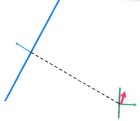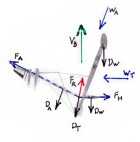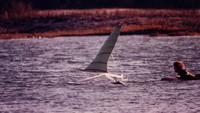High-Speed Sailing
| Vessel Name: | Sailien |
| Vessel Make/Model: | Experimental/custom |
28 September 2013
The America’s Cup
I watched, with interest, the videos of the 34th America’s Cup. At last we have fast sailboats engaged in a competition that is fun to watch. The virtual images (such as course boundaries, distance grid lines, separation between boats, etc.) overlaid on the real images really helps to keep the race [...]
31 August 2013
100 Knots for Hydroptere?
The latest news from Hydroptere is that they have plans for a 100 knot sailboat. This was posted on 26 Aug 2013, so look for that date at this address. http://hydroptere.com/en/the-news/last-news/
17 November 2012
Aptly named Sailrocket, blasts off!
While yet to be ratified, Sailrocket posted an average speed over 500 meters of 59 knots. I will not be surprised if they increase their record into the 60 knot range during this record attempt.
02 January 2012
More drag for VSR2?
I want to start by pointing out that the whole VSR2 team has done a stellar job and has demonstrated conclusively that the forces that drive a sailboat can be aligned for roll stability without using ballast and without using any down-force. (Trifoiler achieved roll stability by using down-force, but [...]
18 December 2011
My analysis of Sailrocket
I copied a diagram of VSR2 (wing doesn’t show well) and added in the major force arrows that apply. Be aware that these arrows are not correct in terms of scale (length) and some of their locations are guesses, however I believe I’m correct enough for us to learn something about what VSR2 has been [...]
23 October 2011
60 is within reach, what’s next?
I have been watching Sailrocket’s progress with great interest and there’s no question they have a winner. I fully expect to see them reach 60kt in the near future. Sailrocket has now demonstrated what I first learned with my models and again with my full-sized prototypes, that if you get the forces [...]
Squeezing Our Craft on Ice or Land
At this point I'll discuss the surface we are sailing on. First will be ice and land then water. As most of us know, ice boats ride on sharp steel runners and have very low friction in the forward direction. These same runners, because of their sharpness have a great resistance to sliding sideways.
If we start sailing straight down wind, with the sail all the way out, notice that the wind's force on the sail is in the direction we are sailing. Since there is so little friction between the runners and the ice, we will accelerate to just below the true wind speed. However, since there are some losses, we will never reach true wind speed. This would be the same idea as if you took that bar of soap and pushed it across the table, it will never go faster than your finger pushing it. If we want to go faster we must change the direction we are sailing relative to the true wind.
Let's set our ice boat at 90 deg. to the true wind. With the sail sheeted out, (luffing - in line with the wind) we will sit there, unmoving, as the wind blows across the craft. This is the same idea as squeezing the bar of soap when the sides are parallel. In this case the force of the wind on the craft is countered by the force of the ice against the side of the runner's edge. Yes, the runner is actually being pushed against the ice, but it comes to the same thing; the runner can't tell if it's pushing the ice or if the ice is pushing it. If we think of the ice pushing against the runner, we have the same situation as our fingers squeezing that bar of soap. One finger represents the ice and one finger represents the wind; the boat is actually being squeezed between the wind and the ice.
Now let's start to sheet the sail in. Almost instantly our boat will start to move forward as the wind glances off the sail. This is exactly the same as the wagon and balloon described earlier and is the same idea as making a wedge of our bar of soap. Note that we can control our speed by the angle we set our sail at. Our top speed will only be limited by how efficient our craft is and for an ice boat most of the losses are aerodynamic.
A land yacht is essentially the same as an ice boat, except it has wheels instead of runners. Because of these wheels, it is not as efficient in its motion against the ground as an ice boat with its runners against the ice. However it is still quite efficient and the currently recognized land sailing speed record is 116 mph. I do not have any data on the true wind speed for that run (if any of you know please tell me).
Next time I'll discuss a sailboat in the water.
Bob
About & Links
- Bob's Surfing Blog
- Bob's Website
- Greenbird (Windjet)
- l'Hydroptere
- Le Projet Dared
- Macquarie Speed Sailing Team
- Monofoil Sailing
- Mountain Goat STOL
- Mr Smith's Amazing Sailboats
- Patent Office (Search)
- Radboat
- Sailien Prototypes (early), Delta, etc.
- Sailien Video
- Sailien Website
- The Basics of Surfboard Design
- The Basics of Surfboard Design en Espanol
- The Swedish Speed-Sailing Challenge
- Trifoiler
- Vestas Sailrocket
- Windjet Project
- WSSRC


